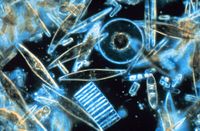
New insights into the biogeochemical cycling of copper in the subarctic Pacific: Distributions, size fractionation, and organic complexation
Sign Up to like & getrecommendations! Published in 2021 at "Limnology and Oceanography"
DOI: 10.1002/lno.11695
Abstract: The chemical speciation of Cu is dominated by complexation with organic ligands. However, the size fractionation of dissolved Cu and its organic ligands are not well understood. In this study, we revealed new insights into the… read more here.
Keywords: subarctic pacific; size fractionation; pacific; organic ligands ... See more keywords

Freestanding 2D NiFe Metal-Organic Framework Nanosheets: Facilitating Proton Transfer via Organic Ligands for Efficient Oxygen Evolution Reaction.
Sign Up to like & getrecommendations! Published in 2022 at "Small"
DOI: 10.1002/smll.202201076
Abstract: The oxygen evolution reaction (OER) is crucial to electrochemical hydrogen production. However, designing and fabricating efficient electrocatalysts still remains challenging. By confinedly coordinating organic ligands with metal species in layered double hydroxides (LDHs), an innovative… read more here.
Keywords: organic ligands; oxygen evolution; proton transfer; metal ... See more keywords

Tailoring Graphene Oxide Framework with N- and S- Containing Organic Ligands for the Confinement of Pd Nanoparticles Towards Recyclable Catalyst Systems
Sign Up to like & getrecommendations! Published in 2020 at "Catalysis Letters"
DOI: 10.1007/s10562-020-03284-y
Abstract: Abstract Graphene oxide frameworks (GOFs) tailored with heteroatom-containing organic ligands were utilized for the efficient confinement of Pd nanoparticles (NPs) to achieve highly recyclable Pd catalysts for Suzuki-Miyaura cross-coupling reaction (SMC). The tailored GOFs were… read more here.
Keywords: graphene oxide; oxide framework; tailoring graphene; confinement nanoparticles ... See more keywords

Improvement effect of organic ligands on chalcopyrite leaching in the aqueous medium of sulfuric acid‑hydrogen peroxide-ethylene glycol
Sign Up to like & getrecommendations! Published in 2020 at "Hydrometallurgy"
DOI: 10.1016/j.hydromet.2020.105293
Abstract: Abstract The addition of ethylenediaminetetraacetic acid (EDTA) to a 1 M H2O2 leaching solution with low concentrations of sulfuric acid (0.007 M) and ethylene glycol (EG) (0.1 M) promotes significant increases of copper and iron leached from chalcopyrite.… read more here.
Keywords: copper; copper iron; ethylene glycol; iron ... See more keywords

Recent advances in 3d-4f magnetic complexes with several types of non-carboxylate organic ligands
Sign Up to like & getrecommendations! Published in 2021 at "Inorganica Chimica Acta"
DOI: 10.1016/j.ica.2021.120318
Abstract: Abstract Since 1993, single molecule magnets (SMMs) have received a wide attention for their potential applications in high-density information storage device, quantum computer and spintronics. Particularly, since a CuII2TbII2 complex was found to possess slow… read more here.
Keywords: several types; carboxylate organic; non carboxylate; types non ... See more keywords

Simple method for functionalization of silica with alkyl silane and organic ligands
Sign Up to like & getrecommendations! Published in 2018 at "South African Journal of Chemical Engineering"
DOI: 10.1016/j.sajce.2018.05.001
Abstract: Abstract 3–(chloropropyl)triethoxysilane (CPTES) with imidazole and sodium silicate from rice husk ash (RHA) successfully reacted within a short time in one–pot synthesis in purely homogenous method. A similar procedure was used for the immobilization of… read more here.
Keywords: silica alkyl; method functionalization; functionalization silica; alkyl silane ... See more keywords

Combined Effects of Fe(III)-Bearing Clay Minerals and Organic Ligands on U(VI) Bioreduction and U(IV) Speciation.
Sign Up to like & getrecommendations! Published in 2021 at "Environmental science & technology"
DOI: 10.1021/acs.est.0c08645
Abstract: Reduction of U(VI) to U(IV) drastically reduces its solubility and has been proposed as a method for remediation of uranium contamination. However, much is still unknown about the kinetics, mechanisms, and products of U(VI) bioreduction… read more here.
Keywords: clay minerals; presence; bioreduction; iii bearing ... See more keywords

Ligand-Induced U Mobilization from Chemogenic Uraninite and Biogenic Noncrystalline U(IV) under Anoxic Conditions
Sign Up to like & getrecommendations! Published in 2022 at "Environmental Science & Technology"
DOI: 10.1021/acs.est.1c07919
Abstract: Microbial reduction of soluble hexavalent uranium (U(VI)) to sparingly soluble tetravalent uranium (U(IV)) has been explored as an in situ strategy to immobilize U. Organic ligands might pose a potential hindrance to the success of… read more here.
Keywords: ligand induced; organic ligands; induced mobilization; noncrystalline ... See more keywords

Influence of Organic Ligands on the Redox Properties of Fe(II) as Determined by Mediated Electrochemical Oxidation.
Sign Up to like & getrecommendations! Published in 2022 at "Environmental science & technology"
DOI: 10.1021/acs.est.2c01782
Abstract: Fe(II) has been extensively studied due to its importance as a reductant in biogeochemical processes and contaminant attenuation. Previous studies have shown that ligands can alter aqueous Fe(II) redox reactivity but their data interpretation is… read more here.
Keywords: electrochemical oxidation; oxidation; organic ligands; mediated electrochemical ... See more keywords

Roles of Organic Ligands in Ambient Stability of Layered Halide Perovskites.
Sign Up to like & getrecommendations! Published in 2022 at "ACS applied materials & interfaces"
DOI: 10.1021/acsami.2c05348
Abstract: The combination of organic ligands and inorganic Pb-I frameworks in layered perovskites has bestowed upon them high structural tunability and stability, while their microscopic degradation mechanism remains unclear. Here, we found the key role of… read more here.
Keywords: organic ligands; ambient aging; roles organic; intrinsic structural ... See more keywords

Three new high-nuclear transition-metal-substituted heteropolytungstates: syntheses, crystal structures, magnetic studies and NLO properties.
Sign Up to like & getrecommendations! Published in 2018 at "Dalton transactions"
DOI: 10.1039/c8dt01613e
Abstract: Three new nickel-cluster-substituted polyoxometalates (POMs), [Ni6(H2O)9(μ3-OH)3(HSiW9O34)]2·12H2O (1), [Ni(en)(H2O)3][Ni6(H2O)3(en)2L(μ3-OH)3(HSiW9O34)]2·9H2O (2) (en = ethylenediamine; L = C7H5O2 = benzoic acid) and [Ni6(L')6(CH3COO)(H2O)3(μ3-OH)3(HPW9O34)]2·9H2O (3) (L' = C5NH5 = pyridine) were successfully isolated under hydro-/solvothermal conditions. 1-3 were structurally… read more here.
Keywords: nuclear transition; transition metal; new high; high nuclear ... See more keywords